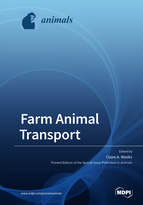Farm Animal Transport
A special issue of Animals (ISSN 2076-2615).
Deadline for manuscript submissions: closed (30 September 2018) | Viewed by 71171
Special Issue Editor
Interests: welfare assessment; transport; poultry; housing systems; markets; knowledge exchange; farm animal welfare
Special Issues, Collections and Topics in MDPI journals
Special Issue Information
Dear Colleagues,
Worldwide about 70 billion farm animals are produced for food with around two thirds farmed intensively. Most of these animals will experience more than one journey, as the stages of production have become more specialised. For example, layer chicks are transported to a rearing facility, then on to a laying farm and finally to slaughter. There is considerable evidence that the stressors associated with handling and transport often negatively affect the health, productivity and welfare of the animals transported. For meat animals transported to slaughter, meat quality may be impaired by stressful conditions experienced during the transportation process. Mortality during transport is common, particularly in poultry, and may be accepted where levels do not have an economic impact, yet this is both an ethical and a sustainability concern.
We invite original research papers that address improved methods for handling farmed animals during loading and unloading, conditions during transit, including vehicle design and on-board monitoring systems, and consequences for animals of being transported in terms of physiology, behaviour and productivity. Additional topics may include the effects of training human handlers and pre-transport conditioning techniques to reduce the impact of transportation.
Dr. Claire A. Weeks
Guest Editor
Manuscript Submission Information
Manuscripts should be submitted online at www.mdpi.com by registering and logging in to this website. Once you are registered, click here to go to the submission form. Manuscripts can be submitted until the deadline. All submissions that pass pre-check are peer-reviewed. Accepted papers will be published continuously in the journal (as soon as accepted) and will be listed together on the special issue website. Research articles, review articles as well as short communications are invited. For planned papers, a title and short abstract (about 100 words) can be sent to the Editorial Office for announcement on this website.
Submitted manuscripts should not have been published previously, nor be under consideration for publication elsewhere (except conference proceedings papers). All manuscripts are thoroughly refereed through a single-blind peer-review process. A guide for authors and other relevant information for submission of manuscripts is available on the Instructions for Authors page. Animals is an international peer-reviewed open access semimonthly journal published by MDPI.
Please visit the Instructions for Authors page before submitting a manuscript. The Article Processing Charge (APC) for publication in this open access journal is 2400 CHF (Swiss Francs). Submitted papers should be well formatted and use good English. Authors may use MDPI's English editing service prior to publication or during author revisions.
Keywords
- Transport
- Livestock
- Poultry
- welfare
- Physiology
- Behaviour
- Meat quality
- Heat stress
- Ventilation
- Handling







